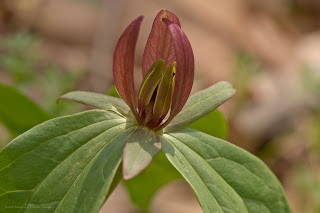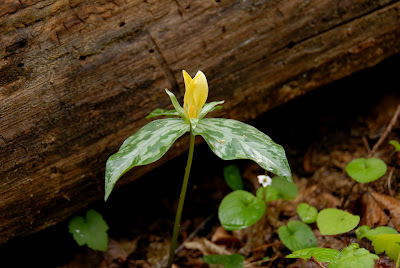Photo: Trillium luteum, Squamatologist
Notice how the flower is sitting erect on top of the leaves. This is the basic look for all sessile type trilliums. Often the sessile trilliums have mottled leaves, but this feature can be variable. There are four species of sessile type trilliums found in the Mid Atlantic: Trillium cuneatum, Trillium discolor, Trillium luteum, and Trillium sessile. Of these four species, only Trillium sessile is found north of North Carolina.
Trillium cuneatum (Little Sweet Betsy, Cuneate Trillium, Large Toadshade, Purple Toadshade, Bloody Butcher)
Photo: Trillium cuneatum, Larry WFU
Trillium cuneatum grows in rich upland woods with limestone based soils. It is the largest of the sessile type trilliums and can grow as high as 17" tall. In the Mid Atlantic it only grows in the mountains and piedmont of North Carolina. Flowers are sessile, standing erect above the leaves and can range in color from the usual purple to rarely yellow. The leaves of Trillium cuneatum are typically mottled. Trillium cuneatum is very difficult to separate from Trillium sessile. To get a proper id you have to look at the anthers of the plant. Below is a drawing I made showing basic flower structure.
Drawing: Jim Brighton
As you can tell from the drawing, the anthers are connected to the filament. Anthers are the part of the stamen that contain pollen. In the blog Get Your Botany On, the author Scott Namestnik, gives a great description of the differences in the anthers of the two species,
"Trillium cuneatum may be confused with Trillium sessile, but the anther dehiscense is latrose in the former and introse in the latter..."
According to wikipedia, "Dehiscence is the spontaneous opening at maturity of a plant structure, such as a fruit, anther, or sporangium, to release it contents.” Anther dehiscense operates by an exact spot on the anther wall breaking and causing pollen to be released. If the pollen is released from the inner side of the anther it is called introse dehiscence. If the split is on the side of the anther positioned towards the other anthers rather than towards the inside or outside of the flower, it is called latrose dehiscence.
Below is a drawing I made showing the different dehiscence.
Trillium sessile (Toadshade, Sessile Trillium, Sessile-flowered Wakerobin, Toad Trillium)
Drawing: Jim Brighton
So basically, where the anther splits and the pollen is released is totally different on the two species. Namestnik also comments on the length of the connectives. The connective, according to the Dictionary of Botany, “is the tissue that joins the pollen sacs in the anther. It is a continuation of the filament…” Below is a drawing that shows where the connective is located on the stamen.
Drawing: Jim Brighton
From the Flora of North America website, I compared the length of the connectives of Trillium cuneatum and Trillium sessile and here is how each species connective is described:
Trillium cuneatum: …connectives straight, scarcely (0.5mm or less) if at all extended beyond anther sacs.
Trillium sessile: …connectives purplish brown, straight, projecting 2 – 5mm beyond the anther sacs.
Supposedly, an easier way to separate the two species is by the leaf tip. On Trillium cuneatum the leaf tip is very pointed, whereas the leaf tips of Trillium sessile are more rounded. A word of caution, leaf tips can be extremely variable and this identification point should only be used as a secondary form of id. Another separation between Trillium cuneatum and Trillium sessile is their odor. Trillium cuneatum has a pleasant faint spicy smell. Trillium sessile's odor is like the smell of rotten meat. Luckily, in the Mid Atlantic region the two species do not overlap, but learning the differences of the two species makes for good practice in learning botanical structure definition. Plus, if you ever go to Kentucky and see a purple colored sessile type trillium, you are going to need the above information.
Photo: Trillium cuneatum, UGArdener
Photo: Trillium sessile, Jim Pater
Trillium sessile is found in rich woods and river plains. I have observed this plant growing along the Potomac in the piedmont of Maryland. It is found much further north than Trillium cuneatum. In the Mid Atlantic region this is the only red sessile type trillium found north of North Carolina. A mature plant is typically around 12" tall. The flowers of Trillium sessile are held erect above the leaves and are typically a deep red. Rarely the flower color can be a greenish yellow. The leaves are usually mottled green. The plant has an unpleasant odor like that of rotten meat. The odor attracts beetles and flies that are the plants main pollinators. Trillium sessile can be easily confused with Trillium cuneatum. The differences in the two species are treated in the above treatment of Trillium cuneatum. Unless traveling outside of the Mid Atlantic region readers should not have to deal with this perplexing identification challenge.
Trillium luteum (Yellow Wakerobin, Yellow Toadshade, Wax Trillium)
Photo: Trillium luteum, Jim Sorbie
Yellow Trillium is found in rich deciduous forests with a calcareous (high in calcium) substrate. It is often found growing along rocky streams. In the Mid Atlantic region Trillium luteum is only found in the Smoky Mountains of western North Carolina near the Tennessee border. A mature plant can grow to 15" tall. Flowers are held erect and have a pleasant lemony odor. Trillium luteum may be confused with the yellow form of Trillium cuneatum. In a few places along the North Carolina / Tennessee border the two species grow together. Once again, you have to get fairly technical to separate the two species. The easiest way to tell the species apart is to look at the color of the stigma. The stigma is the part of the flower that gets pollen from pollinators like insects. The drawing below shows where the stigma is located compared to the other flower parts.
Drawing: Jim Brighton
The stigma of Trillium luteum is greenish white, while the stigma color of Trillium cuneatum is purplish gray. The filaments of the two species are also different colors. The filaments of Trillium luteum are greenish white and those of Trillium cuneatum are brownish purple.
Photo: Trillium luteum, Jason Sturner
Trillium discolor (Pale Yellow Trillium, Mottled Wakerobin, Faded Trillium, Small Yellow Toadshade)
Photo: Trillium discolor, NCOrchid
Trillium discolor is only found in the upper drainage of the Savannah River in Georgia, South Carolina, and North Carolina. The plants are often found in deciduous forests near stream banks or on slopes near streams. Typically, Trillium discolor is smaller than Trillium luteum. Plants are typically no more than 8" tall. Trillium luteum's flowers are pale yellow and held erect above mottled colored leaves. A easy way to differentiate between Trillium discolor and all other yellow sessile type trilliums is the shape of the flower petals. The petals of Trillium discolor are spatulate which means that they are broader at the tip than the base.
Photo: Trillium discolor, NC Orchid
I would like to thank the photographers who made this post possible.
Squamatologist -- http://www.flickr.com/photos/squamatologist/
Larry WFU -- http://www.flickr.com/photos/larrywfu/
UGArdener -- http://www.flickr.com/photos/ugardener/
Jim Pater -- http://www.flickr.com/photos/paterjt/
Jim Sorbie -- http://www.flickr.com/photos/jsorbie/
Jason Sturner -- http://www.flickr.com/photos/50352333@N06/
NC Orchid -- http://www.flickr.com/photos/ncorchid/
I would also like to thank the blog Get Your Botany On. http://getyourbotanyon.blogspot.com/
Part 3 is going to be on the "Nodding" Trilliums. Stay tuned!












No comments:
Post a Comment